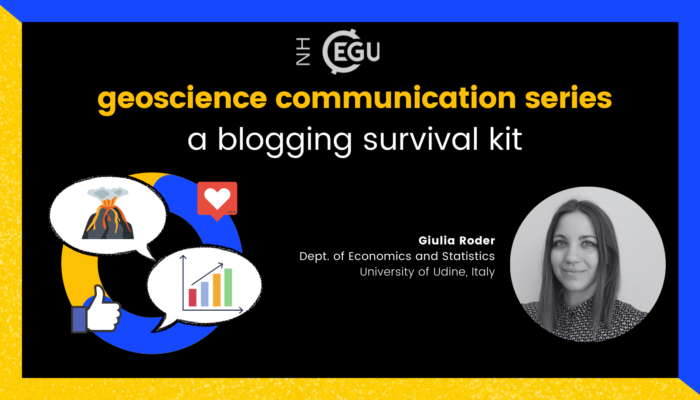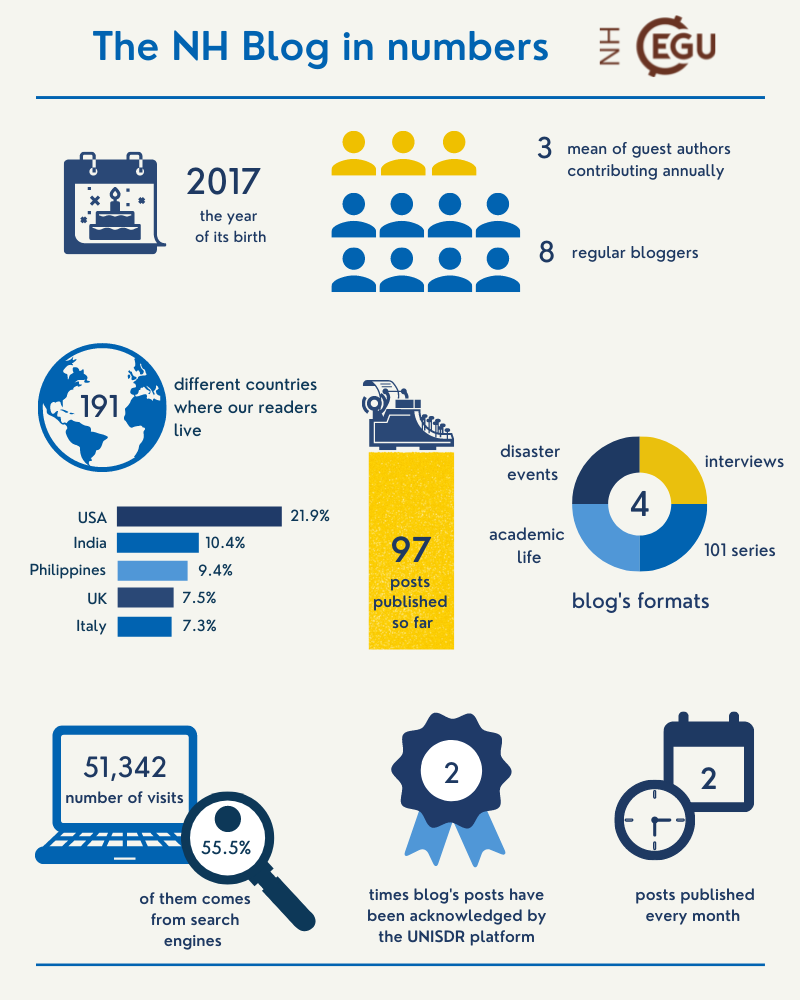
Science communication is the practice of informing and inspiring the public about scientific knowledge. It comes in different forms, from documentaries, books, academic publishing, mass media journalism, to public talks. These days, digital communication, including blogging, vlogging, podcasting, and social media, has become an increasingly popular form of science communication, reaching a wide audience. But how to make good science communication online? Three early-career scientists, Dr Giulia Roder, Dr Iris van Zelst, and Dr Roberto Guardo, have shared experiences and tips to step into online science communication during the EGU webinar “Digitalk: online (geo)science communication”, organised by the ECS group of the EGU Natural Hazards Division last December 7th. If you have missed it, the Digitalk: online (geo)science communication webinar is available on the EGU youtube channel.
We start our journey on online scicomm by exploring scientific blogging with Giulia Roder, editor of this blog, since 2017.
Is blogging still sexy?
That is exactly what we call a catchy title! Yet, writing a blog is more than just a title. But before exploring this world, let’s answer the question: YES, blogging is still sexy. For us, scientific blogging has the romance of reading letters and the ability to spark curiosity into a scientific facet we have never explored before. Is blogging a paved road? NO, it is no picnic.
First of all, you need to clarify your scope. Is it your intention to share your research or academic life, make yourself more visible and enlarge your network or just communicate (geo)science in general, explore interesting publications, interview experts in the field, or share (geo)science fun facts? Motivation drives your enthusiasm through (difficult) time and helps determine your blogging style and content. Reading a lot from the very beginning of your journey can help you take the first steps into blogging. Reading, understanding, and digesting are part of the life of any researcher. Still, when blogging, these activities help you provide the most updated and correct information, and they can be a reference for some basic web searches.
Afterwards, it is quite easy to define the best format for you. If you go for a short post, remember to be general, include informative images, and keep an eye on the word limit under 500 words. If the content needs to be more detailed and specialised, you can reach up to 1500 words. In any case, use a personal touch, do not just describe the events or research articles with a scientific tone. There are many blogs out there: originality is the key! People do not have time to read long and difficult content on a blog, especially when social media digest information and provide quick answers (maybe too much sometimes)!
Another form of a blog post is the interview style, but remember to evaluate the time you have to prepare the questions and post-process the recordings (if you are in a rush, better to opt for a written interview!). A couple of tips to keep in mind: (1) Use s p a c e s, highlight keywords, use italic to catch the reader’s attention. As you see in this text, you are immediately trapped by the layout/style of the text. (2) Pay attention to the copyright of images downloaded from the net. An example of copyright-free pics? Try to google ‘Pixabay’ or ‘Imaggeo’; there are lots out there.
Language does change according to the audience you have in mind. If you speak to your scientific community, opt for English and use technicalities. If your target is the general public, use more accessible terms, including illustrative examples (boxes might be useful to recall difficult terms without losing the reading flow) or comparisons, to help the readers adapt the information to their reality. But be aware: talk simple, not simplistic! The non-expert public also needs to realise the complexity of the result presented or the processed methods. A good scientific communicator can translate science for any specific audience.
Deciding if you want to blog solo or join a team is a tough choice. Flying solo would give you complete freedom, but it would require lots of time to take wing and reach a wider audience. Instead, if you join a team, you encounter more rules and limitations on style and content (sometimes even conflicts), but the time investment is less, and visibility is broader. In addition, as you need to be regular in publication, it can be a good idea to join a team first and practice there before creating your own blog. In this way, your piece is read and edited by a team, which is excellent advice for lonely beginners (you can ask a friend or a peer for proofreading).
Why analytics matter
When the blog is running for quite some time, it could be useful to overview the statistics of the published posts. In other words, you have to check its analytics, which are metrics able to evaluate the performance of the work done so far, helping in tailoring the incoming content. By gathering and analysing blog data, you can get a pulse on your blogs regarding views, time on page, bounce rate, unique and total clicks, individual post-performance, social share and comments, etc. Scientific blogging is not related to a market choice, but similarly, we wish to reach as many readers as possible to confirm our reliability and efficacy; the above metrics can help understand good and bad (and the ugly!) practises and make some strategic choices. Of course, as we will repeat it after, blogging should be motivated by passion. If you become a slave of blog stats, you may end up writing about something you dislike.
How to get bigger and echo your content
Don’t be too hard on yourself first. Realistically, you probably won’t have many readers when you start blogging. At the same time, many people would even judge your content! Take your first steps as opportunities to practice your writing skills, grow your social media advertisement qualities, and most importantly, explore the subjects that you enjoy and that you can sustain in the long-term with that enjoyment. Growing is not easy for bloggers, vloggers, and social media communicators. But you can give it a try with one of these tips:
- Engage experts or famous people in the specific field through interviews or mentioning their work or activities as a successful example. Their visibility can help boost yours as well. Of course, there is no guarantee of success, but at least you improve your communication skills and enlarge your network.
- Use keywords. It may seem trivial, but it is the most effective way to get found in web searches. Never happened to you to find a blog article while on a literature review? Sometimes when you speak about a disaster event, you easily find local news and, more rarely, scientific articles. A blog might be the happy medium between narrative and science!
- Be constant in publishing. To be honest, this is the hardest part. We all blog as a side activity from our professional duties, but regularly publishing can help you get known and enlarge your community.

Figure 1. The NH Blog in numbers
If you wish to have some more details about scientific blogging, have a look at this helpful webinar, available on the EGU youtube channel.
In addition, don’t miss out on the following posts of the (geo)science communication series, where we will explore vlogging with Iris van Zelst and social media communication with Roberto Guardo.
Post edited by: Valeria Cigala and Asimina Voskaki
